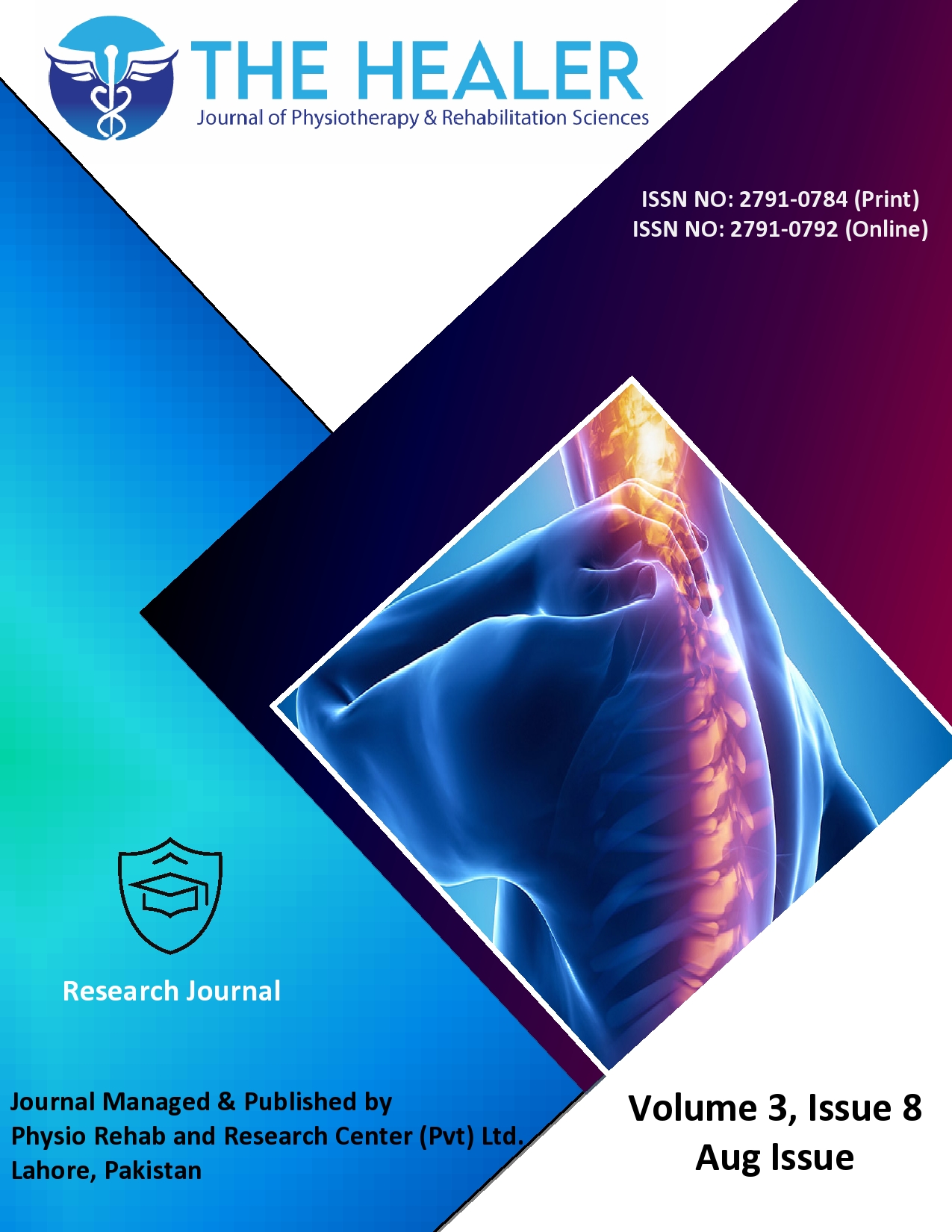Short-Term Effects of Mulligan SNAGs Versus Soft Tissue Mobilization in Patients with Sub-Acute Non-Specific Low Back Pain
Mulligan SNAGs & Soft Tissue Mobilization in LBP
DOI:
https://doi.org/10.55735/hjprs.v3i8.179Keywords:
backache, kinesiophobia, Mulligan SNAGs, soft tissue mobilizationAbstract
Background: Low back pain is the most common health-related problem. Worldwide, one out of three people suffered from low back pain. Currently, the low back dispute is the most common grumble of the functioning age community. The use of mulligan sustained natural epiphyseal glides (SNAGs) as well as soft tissue mobilization is thought to reduce pain, increase range of motion and improve kinesiophobia level. Objective: This study was aimed at finding the short-term effects of Mulligan SNAGs versus Soft tissue mobilization on pain, range of motion and the kinesiophobia level. Methods: It was a quasi-experimental study conducted at Mumtaz Hospital, MuzzafarGarh and Shan-e-Lateef Medical and Surgical HospitalMuzzafarGarh from February 20, 2023, to June 30, 2023. Mulligan SNAGs were given in group A and soft tissue mobilization group in group B. The numeric pain rating scale, range of motion with goniometry and Tampa scale were used for the estimation of outcomes of the study. A total of five sessions were given to each group. Descriptive data was presented as frequency and percentages. Mann Whitney U test was applied. The p-value less or equal to 0.05 was taken as significant. Results: There were a total of 77 participants having sub-acute non-specific low back pain. The mean age of participants was 40.81±39.38 in Mulligan SNAGs and soft tissue mobilization groups respectively. Pain reduction (NPRS mean value after treatment 28.05 and 32.67, increased range of motion (lumbar flexion mean value 50.75 and 42.55), lumbar extension 58.10 and 52.33 and improved kinesiophobia level (Tampa mean value 30.66 and 34.16) respectively in Mulligan SNAGs group and soft tissue mobilization group. Mulligan SNAGs with a p-value of 0.001 showed more significance as compared to the soft tissue mobilization group with a p-value of 0.01. Conclusion: Both Mulligan SNAGs and soft tissue mobilization presented with a reduction of pain, increased range of motion and reduction of kinesiophobia level but more significant effects were in Mulligan SNAGs as compared to soft tissue mobilization.
References
Bhat V, Patel VD, Eapen C, Shenoy M, Milanese S. Myofascial release versus Mulligan sustained natural apophyseal glides’ immediate and short-term effects on pain, function, and mobility in non-specific low back pain. PeerJ 2021; 9: e10706.
Heggannavar A, Kale A. Immediate effect of modified lumbar SNAGS in non-specific chronic low back patients: a pilot study. Int J Physiother Res 2015; 3(3): 1018-23.
Fritz JM, George SZ, Delitto A. The role of fear-avoidance beliefs in acute low back pain: relationships with current and future disability and work status. Pain 2001; 94(1): 7-15.
Gross A, Paquin J-P, Dupont G, et al. Exercises for mechanical neck disorders: A Cochrane review update. Manual therapy 2016; 24: 25-45.
Khan S, Al Torairi N, Shamsi S. Comparative study of SNAGS and Maitland’s mobilization in chronic low back pain. European Journal of Physical Education and Sport Science 2018.
Shetty PB, Balasaravanan R, Ravish V, BN PK. Study on short term effect of modified lumbar snags with conventional program in non-specific chronic low back pain patients. Int J Physiother Res 2020; 8(5): 3639-47.
Crock H. A reappraisal of intervertebral disc lesions. Medical Journal of Australia 1970; 1(20): 983-9.
Peng B-G. Pathophysiology, diagnosis, and treatment of discogenic low back pain. World journal of orthopedics 2013; 4(2): 42.
Nachemson A. Recent advances in the treatment of low back pain. International orthopaedics 1985; 9(1): 1-10.
Manigandan M. Compare the Effectiveness of Maitland Spinal Mobilization Versus Mckenzie Exercise along with Core Stability Exercise on Pain, Range of Motion and Functional Activities in Subjects with Mechanical Low Back Pain: PSG College of Physiotherapy, Coimbatore; 2018.
Hussien HM, Abdel-Raoof NA, Kattabei OM, Ahmed HH. Effect of mulligan concept lumbar SNAG on chronic nonspecific low back pain. Journal of chiropractic medicine 2017; 16(2): 94-102.
Konstantinou K, Foster N, Rushton A, Baxter D. The use and reported effects of mobilization with movement techniques in low back pain management; a cross-sectional descriptive survey of physiotherapists in Britain. Manual therapy 2002; 7(4): 206-14.
Varshney K, Raghav S, Singh A. A study to compare the effect of positional release technique (PRT) versus deep transverse friction massage (DTFM) on pain and disability in patients with mechanical neck pain.
Hidalgo B, Hall T, Bossert J, Dugeny A, Cagnie B, Pitance L. The efficacy of manual therapy and exercise for treating non-specific neck pain: A systematic review. Journal of back and musculoskeletal rehabilitation 2017;
(6): 1149-69.
Pavithra K. A Comparative study on the Effectiveness of Mulligan Technique and Stabilization Exercise on Pain and Neck Disability among Nonspecific Mechanical Neck Pain Patients: RVS College of Physiotherapy, Coimbatore; 2019.
Chitale Jr N, Patil DS, Phansopkar P, Joshi A, Chitale NV, Patil Sr DS. A Review on Treatment Approaches for Chronic Low Back Pain via Mulligans Movement With Mobilization and Physical Therapy. Cureus 2022; 14(8).
Hussein HM, Morsi AA, Abdelraoof NA. The immediate effect of sustained natural apophyseal glide on postural stability and pain in individuals presenting with flexion-dominant chronic low back pain: A randomized single-blinded placebo-controlled trial. J Back Musculoskelet Rehabil 2021; 34(6): 1079-86.
Pal A, Misra A. Effectiveness of snag mobilization on computer profes-sionals with mechanical neck pain and mobility deficit. Int J Physiother Res 2019; 7(2): 3022-27.
Manzoor T, Arshad N, Nasir N, Zia A. Effect of modified lumbar-sustained natural apophyseal glides (Snags) in nonspecific low back pain. Saudi Journal of Sports Medicine 2019; 19(3): 86.
Vanti C, Ferrari S, Morsillo F, Tosarelli D, Pillastrini P. Manual therapy for non-specific thoracic pain in adults: Review of the literature. Journal of Back and Musculoskeletal Rehabilitation 2008; 21(3): 143-52.

Downloads
Published
How to Cite
License
Copyright (c) 2023 The Healer Journal of Physiotherapy and Rehabilitation Sciences

This work is licensed under a Creative Commons Attribution 4.0 International License.
CC BY


